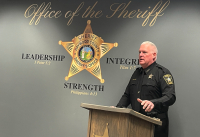Gender equality on pay under the magnifying glass
Western Carolina University has launched a pay study to determine whether male employees are paid more than their female counterparts when doing the same jobs.
The study is expected to take up to two years to complete. It has been some seven years since a formal task force studied salaries at WCU. That was a true labor market study, and not related to gender equity, according to university administrators.
“I think that this is important to do because this type of study has not been conducted in some years,” WCU Chancellor David Belcher wrote in an email to The Smoky Mountain News. “While one can point to there not having been salary increases in recent years as a reason for not pursuing such a study, I think that, nonetheless, it is important for us to understand our current status and situation, knowledge of which will be important context for us in making decisions when money for salary increases is made available.”
Cash-strapped North Carolina isn’t expected to dole out money for raises anytime soon, regardless of study results. WCU professors and staff last received an increase four years ago.
News of the pay review is triggering intense interest on campus, where many faculty and staff have long suspected, believed or oft speculated whether there are indeed salary gender inequities in play at WCU.
Psychology Professor Hal Herzog said that it is common practice at most universities such as WCU for faculty members with identical qualifications, experience and work loads to make vastly different salaries.
“The role that sex discrimination plays in these differences is complicated by the fact that faculty salaries are closely tied to the field people are in,” Herzog said.
For example, faculty members in accounting, finance, information systems, and economics — mostly men — make more money than those in the English department — mostly women, he said. A comprehensive analysis of sex differences in pay needs to take factors like these into account, Herzog said, adding that he remained “mystified” why it would take WCU two years to conduct such a study.
“After all, salaries of state employees are a matter of public information,” Herzog said. “This is not rocket science.”
Laura Wright, an associate professor in WCU’s English department and president of WCU’s chapter of the American Association of University Women’s Tarheel Branch, said the two-year block of time seems in line with a similar study proposal by the group. The national group focuses on such issues as gender equity, and local members wanted to formally examine WCU’s salaries.
“That’s not any different from our proposed timeline, so I am not comfortable saying that two years is too long,” Wright said. Wright added that she’d like it “put forth,” however, that she is an English professor and not a statistician.
Wright said what does disturb her, on the face of it, is the disparity in the number of full professors and women in leadership positions at the Cullowhee university.
“I know that these discrepancies are not and cannot be the result of women doing less and inferior work,” she said. “They are the product of a university culture that has historically not fostered and supported women’s leadership and advancement.
“The fact that Chancellor Belcher has chosen to explore this issue seems like a good thing to me,” Wright said, adding that she fully supports his efforts to identify and rectify possible inequities.
WCU students stage drag show to get out the vote against gay marriage proposal
A student club at Western Carolina University is defending its decision to pair a drag show featuring “kings” and “queens” from across the state with a get-out-the-vote drive aimed at defeating a proposed state constitutional amendment that would ban same-sex marriages.
“We could open up a shelter for puppies and those who hate us would still hate us; that’s no matter what we do, drag show or no drag show,” said Katlyn Williams, 19, a WCU student from Andrews.
The drag show is an exclamation point on a day filled with educational events about Amendment One. Gay-marriage supporters believe an anti-gay marriage amendment would constitutionalize state-abetted discrimination in North Carolina.
This is not the first drag show at WCU. A drag show held last April at the University Center at WCU attracted upwards of 450 spectators, according to members of the student group UNITY!
“We have not in the past few years had any issues with the community at any of our events,” said club leader Zachery Reedy, 22, a former WCU student from Chicago. Reedy isn’t enrolled this semester. He said that he plans to return to classes at the university to complete a degree.
Drag shows divisive among gays
UNITY! members described the drag shows at the University Center as popular among homosexuals and heterosexuals alike. Audience members, they said, are from both on and off campus.
The shows feature men and women dressed as members of the opposite sex, usually with exaggerated personas, who dance, sing or lip-synch to music. Drag shows are becoming ever-more mainstream with the advent of performers such as RuPaul and the mind-bending, drag-queen imitating Lady Gaga.
But, drag shows historically have been a source of vehement disagreement within the gay and lesbian community. Some gays and lesbians believe the high energy, campy shows fuel stereotypes and further alienate many “straight” people from serious efforts to ensure equality for all. Drag show critics say that queens in particular underscore harmful stereotypes of women — similar to what blackface performances by white entertainers did to demean African Americans.
UNITY! club members reject that argument.
“The reason for the drag show is as an incentive to vote,” Reedy said. “Our goal for this day alone is to register 500 people to vote.”
Reedy and other UNITY! members said they do not believe coupling the drag show with the get-out-the-vote effort trivializes or dilutes the political importance of the event. Nor do they believe it might alienate more mainstream “straight” voters who are undecided about whether to vote against the same-sex marriage ban.
The event, coupled with educational efforts, “is a good opportunity to get all people to vote,” said Megan Bailey, 19, who is from Florida but more recently lived in Wilkesboro.
Bailey is leading the voter-registration portion of WCU’s “Race to the Ballot.”
WCU backs students’ drag-show decision
UNITY! faculty advisor Laura Cruz supported students’ decision to hold a drag show in conjunction with a get-out-the-vote rally. She said her role with the group is to guide, not dictate.
“It is a student organization run for and by students,” said Cruz, who made her way to Western North Carolina from San Francisco. “If I think they are going in a wrong direction, I can steer them another way.”
In this case, however, Cruz said she didn’t perceive the decision to hold a drag show as troublesome. Though, she noted, “there is some controversy within the gay community itself about the meaning of drag.”
But UNITY! sponsors drag shows “all the time” at WCU, said Cruz, who is an associate professor of history. The events lined up for Jan. 27 met the club criteria “for support, social events and advocacy.”
Although the University Center is a building owned and managed by the university, its purpose is to serve as a venue for students.
Sam Miller, WCU vice chancellor for student affairs, said that he believes the get-out-the-vote event, coupled with a drag show, is an appropriate on-campus activity.
“I think the job of a public university is to provide both the intellectual framework for students to explore and learn, as well as the physical venues to do so,” Miller wrote in an email interview. “Learning happens in many surprising ways outside the classroom experience. It takes leadership, knowledge and organizational skills to pull off a successful event. The university has a responsibility to stand behind our students and facilitate their learning in their events and activities, as well as the classroom.”
Miller wrote that the University Center was built to help create and support a “broad range” of student-created programs. The University Center, residence halls and similar on-campus facilities are paid for through student fees, Miller noted.
Zero state or tuition dollars are used to pay for social or entertainment-focused student activities, though state funds are used to help support “unique learning opportunities” such as special lectures or other events created in support of curriculum, Miller wrote.
WCU students help children with autism
A local fly-fishing guide and recreational therapy students at Western Carolina University teamed up recently to provide a fly-fishing outing for children with autism.
Jennifer Hinton, WCU associate professor of recreational therapy, organized the event. Alex Bell, retired principal of Smoky Mountain High School and the owner of AB’s Fly Fishing Guide Service, served as “coach” on the project, working with the class throughout the semester.
Through the Adaptive Fly Fishing Institute, Bell teaches adaptive fly fishing and also teaches fellow instructors in the practice. There is limited research on adaptive fly fishing, Hinton said, but the WCU students theorized it would benefit children on the autism spectrum physically, psychologically and socially.
The fly fishing was adapted to the children’s abilities. For instance, when teaching the children to cast, the instructors asked them to aim for hula hoops on the ground rather than the more typical method of using numbers on an imaginary clock face.
“It was amazing the difference once we put down a visual cue. It improved their focus so much,” Bell said.
Autism affects the normal development of the brain in the areas of social interaction, communication skills and cognitive function, according to the National Autism Association. Individuals with autism can show marked differences — thus, they are on the “autism spectrum” — but typically they have difficulties in verbal and nonverbal communication, social interactions and leisure or play activities. The NAA reports that the disorder affects one in 150 people in the U.S. and is diagnosed four times more often in boys than girls.
In honor of the event, staff of the N.C. Wildlife Resources Commission stocked a section of Cullowhee Creek with about 40 brook trout from the Bobby N. Setzer State Fish Hatchery in Brevard.
“We’re here to provide angling opportunities for various people, and we were proud to step up and make that happen,” said David Deaton, a WRC fish production supervisor.
A week later, Kathy Ralston said her son Isaac was still talking about it.
“He’s looked forward to fly fishing since we moved here,” said Ralston, who with her husband, Bill, an orthopedic surgeon at MedWest Harris, and their four children relocated to Jackson County from Kansas City, Mo., in August 2010. Though it’s unusual for children on the autism spectrum, the Ralstons have always had Isaac, their oldest child, participate in group activities such as organized soccer.
But participation has gotten more difficult as Isaac has grown older and the physical and emotional disparities between Isaac and his peers have become more pronounced. Ralston and other parents expressed a desire for more recreational opportunities for their children with autism spectrum disorder, such as the fly-fishing event.
Origin of WCU white squirrel a mystery
A rare sighting of a white squirrel at Western Carolina University has workers there abuzz.
The squirrel has been spotted a number of times, and is clearly not albino because it doesn’t have pink eyes, said Roger Turk, grounds superintendent for WCU’s facilities management department.
There is a large population of 1,500 or so white squirrels in Brevard, a unique phenomenon intrinsic to that area. Sightings are unusual outside Transylvania County, although not entirely unheard of. Whether the white squirrel in Cullowhee is an offshoot of that population, or simply a variation of the Eastern Gray Squirrel living at WCU, isn’t known.
Jim Costa, a WCU biology professor and director of the Highlands Biological Station, said it’s possible the white squirrel strain from Brevard migrated to Cullowhee — but it might also be a separate strain that evolved on its own.
“Squirrels disperse over the generations, but the one sighted on campus did not necessarily originate in the Brevard population — it may have, or it may be a color variant that arose recently in the local population,” said Costa.
A couple of years ago, Costa saw a white squirrel between Cashiers and Highlands, but that’s the only time he’s seen one very far from Brevard.
“As you can imagine there’s a pretty stiff penalty for being a white squirrel in an area with loads of hawks and such, but they manage to hold their own in Brevard,” Costa said.
In Brevard, the white squirrels have a distinctive black cap and black saddle that WCU employees aren’t reporting seeing on their white squirrel.
“The markings are noticeable,” said Madrid Zimmerman, director of the Brevard Main Street program.
Regardless of its origins, the sighting at WCU has been exciting for those lucky enough to catch a glimpse. The white squirrel has been seen around the baseball fields and the greenhouse and at least once, by an off-campus witness, near St. David’s Episcopal Church behind the Ramsey Center.
WCU’s Turk hasn’t seen the creature himself, but several of his employees have — and they’ve gotten good, long looks at the animal, he said.
“It’s been seen six to eight times,” Turk said. “So far they’ve only seen the one.”
Lynn Warner of Heart of Brevard said it isn’t that unusual for them to field calls from excited individuals who’ve seen white squirrels outside of Brevard.
“People call and say, ‘I’ve seen one,’” Warner said. “And they’re fascinated.”
But when you’ve got as many of the creatures as Brevard does, it’s hard to overly impress the workers in that town.
The white squirrel population in Brevard, according to annual white squirrel counts, is growing larger, Warner said. They currently make up a significant percent of the squirrel population there; some biologists believe the white color might one day dominate over gray-colored squirrels, she said.
The 2010 count recorded 37.1 percent white-versus-gray, the highest yet on record, in Brevard, well above the 14-year average of 28.1 percent, according to Brevard’s White Squirrel Research Institute.
One of the prime viewing sites for white squirrels is Brevard College. The town and college are so proud of their white squirrels Brevard holds an annual White Squirrel Festival and a Squirrel Box Derby.
Brevard residents commonly — and happily — put out birdseed for the white squirrels, Zimmerman said, but they try to discourage the gray squirrels from feasting.
“We all brake for white squirrels. We think twice for gray squirrels,” she said, only seemingly in semi-jest.
The story behind the population in Brevard seems a mixture of fact and lore.
According to history, the white squirrels there originated from a circus truck that overturned in 1949 near the home of a man in Madison, Fla. (this according to www.whitesquirrels.com). He gave two white squirrels to another individual, who bequeathed them on Barbara Mull, a longtime resident of Brevard.
She kept them inside and hoped they might breed, but they didn’t. In 1951, one of the white squirrels escaped outdoors. Not long afterwards, Barbara’s father let the other white squirrel free.
Before long, white squirrels were seen about Brevard. And now, at WCU.
Brevard takes its squirrels seriously
A town ordinance states: “The entire area embraced within the corporate limits of the city is hereby designated as a sanctuary for all species of squirrel (family Sciuriadae), and in particular the Brevard White Squirrel. It shall be unlawful for any person to hunt, kill, trap, or otherwise take any protected squirrels within the city by this section.”
Lockdown, quick arrest follow bank robbery near WCU
A bank robbery at the N.C. State Employees Credit Union last week in Cullowhee saw a series of recent safety measures at Western Carolina University suddenly transform into the real thing.
In 2007, a shooter went on a rampage at Virginia Tech, resulting in universities across the nation reviewing and implementing safety protocols such as the ones WCU put into action.
The Cat Tracker, a WCU notification system previously used only to report class cancellations and scheduling changes because of weather, was activated. Sirens on campus sounded, and local and university law enforcement officers shut the campus down until a suspect, a WCU junior from Hendersonville, was arrested at his nearby apartment.
The lockdown meant students and faculty across campus were ordered to stay in rooms or buildings they were in. This precaution also applied to the standing-room only crowd gathered in the Ramsey Center’s hospitality room for a press conference unveiling the university’s new athletic director — a crowd that included Chancellor David Belcher.
Norman West, a real estate agent from Cullowhee, accepted the several-hour lockdown with patience, as most in the room seemed to do, saying he understood the necessity for the procedure. He did worry about making it to a funeral he’d planned to attend.
“Last time I remember something like this was a bomb scare in college,” West said.
The shut-ins included a number of reporters from news outlets across Western North Carolina. They were covering the athletic director announcement, ensuring the lockdown received ample and detailed coverage across the region as the journalists witnessed it first hand.
WCU Spokesman Bill Studenc described the lockdown and other safety measures that were instituted following the 10:20 a.m. robbery on Dec. 14 as proceeding “fairly smoothly.” He said that campus leaders planned to review the situation and correct any problems.
Some business owners on the Catwalk near campus complained that WCU’s radio station did not provide an alert, causing confusion as the sirens howled, and leaving restaurants still accepting and serving customers with doors open and unlocked.
Robin Lang of Catnip Café said those on the strip finally learned what was happening via the notification system, which consisted of text messages, voice calls and emails. There were reports, Studenc said, of “some members of the campus community (who) did not heed the shelter-in-place advisory and were moving about on campus. As part of our post-incident evaluation, we will be looking at this issue and work to find additional ways to address it.”
Suspected robber used plastic gun
Deputies arrested student Brian Anthony Edwards, 21, of a Hendersonville address, on armed robbery and possession of stolen property charges. He was arrested at his apartment on Pointe Lane in Cullowhee at 12:45 p.m., a little more than two hours after the robbery.
Edwards robbed the credit union of $3,343 using a plastic gun, according to court papers on file at the Jackson County Courthouse. In the warrant issued for his arrest, the “gun” was described as closely resembling an automatic-style weapon.
Bank employees reported to police that the robber had run from the credit union on foot, and that a dye pack given to him in the stolen money exploded, according to a search warrant application written by Jackson County Detective John Buchanan.
Eyewitness descriptions of a getaway car matched an SUV found parked at “The Peaks” apartment complex.
“Jackson County deputies spoke to the owner of the vehicle and after an interview the owner of the vehicle confessed to robbing the bank, and the money was inside the apartment,” Buchanan wrote.
An inventory of items seized during a search of Edward’s apartment and vehicle included a black plastic gun under the SUV’s front passenger seat, clothes that appeared to match descriptions of ones worn by the robber also in the SUV, and a black mask on a bed in the apartment.
Edwards was jailed in lieu of a $250,000 secured bond.
WCU students hope new athletic director will turn the tide
Randy Eaton has been selected Western Carolina University’s new athletics director and the man designated with rescuing the school’s floundering football program.
He was greeted last week by a throng of Western Carolina University coaches, administrators, faculty and staff. Some students also turned out to meet and greet Eaton.
Abraham Faison, a freshman from Burlington and a member of WCU’s track team, was among those Dec. 14 in the standing-room only crowd in the Ramsey’s Center homecoming room. Faison said he hopes Eaton can turn around a football program that has experienced a decided losing streak. This year, the team won one game, and the last winning season was 2005, when WCU’s football team went 5-4.
Eaton promised the crowd to hire a new football coach by Christmas.
“I came because I wanted to show my support,” Faison said, adding that he also wanted to meet the man chosen to lead all of WCU’s sports programs, including track and field.
Eaton, 50, most recently served as senior associate director of athletics at the University of Maryland.
Eaton’s first job is to replace former Football Coach Dennis Wagner, who posted an 8-36 record in his four-year career at WCU. Wagner was forced out last month, sent on his way with a $300,000 settlement for having his contract terminated. WCU, trying to find the key to a competitive football team, has now bought out the contracts of three football coaches in a row.
A football coach could be named as early as this week, with the university Board of Trustees meeting Wednesday to consider a name.
Eaton replaces Athletic Director Chip Smith who was fired in October, paving the way for Chancellor David Belcher to hire Eaton.
The new athletics director will receive $160,000 a year under the terms of a contract that runs through June 30, 2016.
“What impresses me most about Randy is his unwavering commitment to the student-athlete and the fact that he understands that the word ‘student’ is the most important part of that hyphenated term,” Belcher said. “He is totally committed to the concept that these young people who come to our university are students first, and athletes second. That’s not to say that Randy does not want success on the fields and courts of play, because he shares the same expectations of excellence that I have for all of our sports teams.”
Belcher touted Eaton’s “passion for winning.”
Shawn Dholakia, a student manager for the WCU men’s basketball team, said he attended the meet and greet because he’s excited about a possible new and positive direction for WCU athletics.
“I’m interested in athletics, and I’m involved in it,” Dholakia said. “I wanted to hear what he had to say.”
Randy’s resume
WCU’s new athletic director Randy Eaton until last week was serving as the senior associate director of athletics at the University of Maryland. He joined the Terrapins’ athletics program in 2003 as associate director in charge of business operations. At Maryland, he was the No. 2 administrator in the athletics department and oversaw a $60 million annual operating budget. He served as interim director in 2010 and recently assumed additional responsibility for new revenues, facilities and operations.
Eaton, in addition to his stint at Maryland, also has held positions at the University of Houston, Texas A&M University, East Tennessee State University, Ohio State University and the University of Texas at San Antonio, and with the Ohio Glory of World League Football.
From purple ties to Liz Claiborne handbags, purple apparel all the rage at WCU
Just one day after being named Western Carolina University’s athletics director, Randy Eaton was shopping for purple-colored clothing at the school’s gift shop.
He had figured out, in a mere matter of hours, that at WCU employees are expected to dress in purple — and lots of it. The Catamount colors are purple and gold.
Though not wearing purple probably isn’t a firing offense, and technically at least your choice of dress colors isn’t tied to receiving tenure, if you don’t follow the “Power of Purple” unofficial dress code you’re going to feel mighty lonely in crowds of your coworkers here. Not to mention those “Purple Fridays” when employees are encouraged to participate by dressing — you got it — in purple.
Peer pressure operates at any age level.
Eaton, like other coaches and sports types here, has it relatively easy. He can simply walk into the on-campus gift shop and buy athletic apparel sporting the school’s logo and consider himself a fashionably dressed chap about campus. Other men at WCU, even administrators and professors or staff, don’t have it all that difficult, either. Sure, it’s a bit of a chore to find purple ties, but they are out there for the purchasing, including right here in Sylva.
“You can get this stuff at Walmart,” said Bill Studenc, the head of WCU’s public relations department as he fingered his purple tie.
Pity the poor women at WCU, however. You just aren’t going to find haute couture at a box store. They are instead left to scour the earth for purple.
“Anywhere I can get my hands on it, I buy it,” said Jennifer Brown, WCU’s associate athletics director. “Belks, T.J. Maxx, wherever.”
“Yes, it is power shopping with a goal in mind,” agreed Sue Arakas, an Asheville native who serves as associate commissioner for the Southern Conference. She was here to welcome Eaton to his new post at a press conference and reception last week.
Arakas, who must make visits to all 12 universities in SoCon, buys a variety of clothing to meet each school expectation. On this day, she was sporting a purple top, hurriedly purchased for this visit to WCU — one must be careful not to show up in, say, the blue and white colors of The Citadel when visiting this rival campus. If all else fails, Arakas reaches for pink.
“That’s nobody’s colors,” she said in explanation. And, unlikely ever to be — what self-respecting football team is going to dress out in pink?
WCU Assistant Women’s Basketball Coach Jonelle Streed has learned during her three seasons here that there’s a simple, and inexpensive, way to meet WCU’s purple-fashion madness.
“Just go black, and buy and wear purple undershirts with it,” Streed said.
But one must be careful with black, said Jill Ingram, who works in public relations for the university. Pair black with the WCU school-color gold, and you might find yourself burned at the stake or something along those lines. Black and yellow is arch rival Appalachian State’s school colors.
Ingram was suffering deeply at this event from an unmistakable, never-to-be-forgotten fashion faux pas: she’d forgotten about the Eaton event, and arrived not in the obligatory purple, but in a raspberry-sorbet colored sweater.
Never fear, Ingram said, she does have purple-colored clothing in her closet.
“Every time I go to consignment or thrift, I look for purple,” she said nervously as she defended herself from possible censure.
Purple items, in these days of massive university layoffs, are probably more easily available in Jackson County’s used clothing shops than ever before.
Ingram, like other women at the event, expressed awe and a certain measure of envy over Susan Belcher’s ability to not just stylishly wear purple, which she certainly does, but to actually accessorize each outfit. On this day, Belcher was dressed in black with a purple top and purple earrings, a purple necklace and a Liz Claiborne purple handbag.
Belcher’s husband, David, became chancellor this summer. Belcher immediately understood that unlike at their last school posting, the University of Arkansas at Little Rock, where the school colors of maroon and silver were rarely worn outside of sports events, purple dominates at WCU — from the classroom to the ballroom.
“I look everywhere for it now,” Belcher said. “When I see purple, and if it’s affordable, I buy it. You can’t go overboard, you can’t wear too much purple at WCU.”
Fortunately, Belcher said, purple is “in” this year, allowing her to stock her closet for possible drought years in the future.
Chancellor fields football question
SMN: The $300,000 to the football coach represents at least three professors’ salaries. Is this cost worth trying to have a winning football program? Why pump this kind of money into athletics compared to academics in this day and age of massive economic constraints?
Chancellor David Belcher: “As I’ve said many times in my visits across Western North Carolina communities in recent months, I view athletics as a very important part of the university, for several reasons.
First, athletics plays a role in the development of student-athletes who participate in sports, providing them with leadership skills and helping instill in them foundations of teamwork and discipline that they will carry with them for the rest of their lives. Thus, athletics experiences are part of their educational pursuits.
Second, athletics is a critical component of the overall student life experience by helping ground students in the campus community and keeping them engaged in the university outside of the classroom. Third, athletics also helps keep alumni and friends connected to the institution, giving them something around which they can rally.
And fourth, athletics, just like the arts and cultural events, serves as a front door to the university, offering an entry point for folk in the community and the region who might not otherwise have a reason to set foot on our campus.”
What price athletics? WCU football costs mount as university pursues wins
The price tag of transforming Western Carolina University’s losing football team into a winner — or anything less than a total embarrassment to Catamount fans — keeps rising, leaving students, alumni, faculty and staff at odds about whether the cost is just too high.
So how much is too much?
WCU recently paid $300,000 to buy out the latest head football coach deemed a loser. Dennis Wagner is the third straight coach WCU has bought out since 2001. And now, WCU wants to kick more than $1 million into the salaries of a new athletic director and for a replacement football coach.
Punt already, some students said this week: It’s just not worth it, particularly when students are facing a just announced, almost certain to be implemented $399-a-year increase in annual tuition and fees.
Other students, however, are calling for a push toward the end zone: a winning football team, they argued, is an integral part of a student’s university experience.
Chancellor David Belcher makes that argument, too.
“I feel that a successful athletics program is critical to a university,” he said in an email interview with The Smoky Mountain News. “And football, while just one part of an overall athletics program, is an important and visible component. In our region, it is fair to say that football is the most visible sport.”
High costs keep escalating
A typical WCU undergraduate student living on-campus and eating at the cafeteria can expect to pay $11,775 next year. Of that amount, $688 from each student will help fund the university’s athletic programs — a $71 increase when compared to last year.
By comparison, Wagner received $940,000 via WCU’s coffers for the four years he was on the job, including the $300,000 contract termination settlement.
“I just don’t think the football coaches should get paid what they’re paid,” Joshuah Gross, a WCU student said bluntly, shaking his head over the amount of money Wagner pulled down.
Gross ran out of money to attend WCU and is headed to a local community college to continue his education. He works at Rolling Stone Burrito on campus to earn his living.
“The team is terrible, and here they are planning to sink even more money into a failing program,” Gross said one day last week. “The professors are suffering — they need to redirect that money into other areas, like into the engineering department.”
WCU administrators have seen cash-strapped North Carolina cut the university’s budget $32 million since the 2008-2009 year.
Senior T.J. Eaves, the student body president at WCU and a former high school football player, views the situation differently than Gross, his former university classmate.
“To the student body a good team is very important. It directly contributes to the student experience,” Eaves said, adding that he believes most students “were excited for a change in the program.”
And, Eaves emphasized, most students supported Chancellor Belcher’s decision to make changes, including paying a failed football coach that $300,000 buyout fee.
Belcher didn’t shy from confirming that he was hired by WCU with certain expectations when it comes to the football team.
“In my conversations with the search committee, and later with the Board of Trustees, it became clear that improving the performance of the athletics program would, indeed, be an expectation of the next chancellor,” Belcher said. “And that expectation meshes perfectly with my expectations. I expect excellence in athletics, including football, just like I expect excellence in academics, in our Honors College, in our marching band, in everything we do at Western Carolina.”
Making tough decisions
WCU’s football program has been on a decided losing streak, winning only two or three games a year and garnering some nine losses. This year it won only one game. The team’s last winning season was 2005, when WCU went 5-4.
“My roommate and I went every time they were home playing this season,” said graduate student Tim Willis. “And the football team was really bad. That’s not an opinion, that’s a fact. Nobody at Western gives a (expletive) about the football team — we are all there for the marching band. They are just great.”
Willis wants to see WCU pump money back into academics, not sports.
But it just isn’t that simple, Faculty Senate Chair Erin McNelis said. Prior to joining the Faculty Senate, McNelis said she hadn’t really understood the budgeting formulas universities labor under.
There’s different pots of money, and “that’s not money we (academics) could have had anyway,” said McNelis, a math and computer science professor. “And, while my interest is predominantly academics, I recognize that students’ educations include more than that — we have an engagement component.”
Academics are funded primarily through the state and tuition. But athletics have their own funding stream, including ticket sales, sponsorships and donations.
The lion’s share — $5 million of the $8.4 million athletics budget — comes from the $688 fee assessed to each student to pay for sports.
The university also kicks in $1.2 million, justified as institutional support because it goes toward scholarships for student athletes and to pay the salaries of coaches who also teach academic courses. The university plans to phase out this funding over the next four years, however, making athletics self-sustaining.
Jason Lavigne is chair of WCU’s Staff Senate and a database administrator for the university. He’s also a WCU alumnus, and a fervent believer in building the university’s football program.
“Like it or not, the football team is a big face of the university,” Lavigne said.
Alumni pride means big bucks
Coach Wagner’s exit followed an undistinguished 8-36 record, including a recent 51-7 shellacking during homecoming by the University of Tennessee at Chattanooga football team. That horror led to outcries from alumni, which helped in the forced exodus of Athletic Director Chip Smith, who had previously extended Wagner’s contract. The WCU Board of Trustees, it should be noted, had endorsed the contract extension.
Fred Cantler, WCU’s longtime senior associate athletics director for internal operations, came out of retirement to serve as interim director of athletics. WCU is expected to name a new athletics director Wednesday, Dec. 12.
“Not all of a student’s collegiate experience is inside the classroom,” Cantler said. “It’s very important that the university’s programs are successful.”
One huge reason is financial, university leaders acknowledged. Happy alumni make more frequent, and substantially larger, donations.
“Obviously, the more success that teams are having on the fields and courts of play, the more likely alumni and other donors are to contribute toward those programs,” Belcher said. “It’s human nature to want to rally around a winner. But more important than winning, I think, is being sure that we are able to field teams that are competitive … (that) translates into both a larger number of donors and into higher amounts of donations over time.”
Laura Leatherwood of Haywood County has three degrees from WCU. She served on the search committee tasked with picking the university’s replacement athletics director.
Asked whether WCU had difficulty finding anyone willing to take the job, Leatherwood laughed and replied “no” — there were many eager candidates, she said, adding that the selection they made should prove an excellent one.
Leatherwood said athletics, along with other university programs, help students with “professional development, personal development and their networking” abilities. It helps build “good character,” she said. And, like so many others, Leatherwood emphasized that the university experience isn’t isolated to academics.
Betty Jo Allen, president of the WCU Alumni Association, could have been singing a duet with Leatherwood. Allen lives in Lincolnton and drove here to WNC to attend every home game played in Cullowhee this season.
“I’m a big supporter of the team,” said Allen, who attended WCU from 1964 through 1968. “I love athletics, and I love football.”
Allen taught in North Carolina’s public school system for 37 years. She emphasized that what is often lost in the argument about football at WCU is that the arguing is about kids — the football players are students, too. They might be losing games, but they are still just young adults trying to find their ways in the world, Allen said.
She added that it should be noted that the cumulative grade point average of WCU’s football team for spring semester 2010 (2011 fall semester still being under way), was the highest in recent memory.
That said, Allen still wants a winning football team as much as anyone associated with WCU.
“I want us to be competitive,” she said. “In everything. I want it all.”
Asked if the price tag is simply too high when academics at WCU are suffering from what Belcher himself has described as “staggering cuts,” Allen hesitated, then said: “I’m just really glad I’m not the one who has to make those kinds of decisions.”
WCU athletics by the numbers
• $8.4 million Total athletic budget
• $1.4 million Athletic Departent deficit over four years
• $400,000 projected deficit for this year
• $1.275 million Amount contributed by university
• $5 million Amount raised through student fees
• $688 Student fee assessed this year
• $71 Increase in per student fee over last year
• $252,000 Amount from ticket sales
• $55,000 Decrease in ticket sales compared to last year
• $19,000 Decrease in sponsorships/royalties compared to last year
• $4,500 Decrease in novelty/program sales compared to last year
• $2.46 million Amount spent on athletic scholarships
Catamount comeback: Can new athletic director turn Western football around?
Western Carolina University hired a new athletic director this week who will face the daunting challenge of turning the college’s losing football team around.
The official announcement will be made on campus Wednesday morning with an appearance by the new AD.
The new AD will face the tall order of rebuilding the football program — something that his predecessor failed to do and by all accounts is the reason he isn’t there anymore.
Sports has seen a renewed emphasis under Chancellor David Belcher, who pledged to improve the athletic department when he took over this summer.
“Athletics is a front door or front porch to the institution,” Belcher said last month during a kick-off for the athletic director search. “Athletics provides visibility for the university, it grounds students in the institution, and it is a way to keep in contact with donors and alumni.”
Belcher called the hiring an “important decision.”
A 15-member search committee culled through 75 applications for the athletic director position during the month of November, a recruitment process aided by the hired consulting firm Collegiate Sports Associates.
The search committee narrowed the field to seven candidates for interviews. Their top two finalists were passed along to Belcher last week, who made the final pick. While names have not been released by the university, the Asheville Citizen-Times and WLOS have reported that Tom Kleinlein, the deputy athletic director at Kent State, and Randy Eaton, Maryland’s senior associate athletics director for new revenue, facilities and operations, were finalists.
Belcher then held a conference call meeting of the WCU Board of Trustees Monday morning to get approval for the salary, benefits and contract being offered for the new AD. While the choice of who to hire is Belcher’s, the contract terms must be approved by the trustees. The salary will be $160,000 with a five-year contract until June 2016.
After the meeting, Belcher formally extended the offer, and it was accepted.
Game on
Job No. 1 for the new athletic director will be hiring a new football coach. It might not be as easy as it sounds. Since 2001, WCU has sent three football coaches packing before their contracts ended for losing too many games.
The most recent causality was former coach Dennis Wagner, forced out just before the last game of the season. The assistant head coach met a similar fate.
In four years, Wagner won only eight of the 36 games the team played. This season was the worst, however. Wagner won just one game this year — a statistic that ultimately brought the athletic director down as well.
Former Athletic Director Chip Smith was blamed at least in part for the football coaches’ failures — or at the very least for keeping the coaches around despite their poor showings. In his seven years at WCU, Smith twice supported extending the contracts for coaches who were later fired. And in both cases it cost the university, which had to pay out settlements for terminating the coaches’ contracts.
While WCU is paying Wagner $300,000 for the two years left on his contract, the negotiated settlement is less than the full amount his contract called for — a compromise both sides felt was in their best interest.
During the athletic director search process, Belcher said he wanted someone who could “hire, retain and mentor excellent coaches.” But it will also take financial savvy and a good PR face.
WCU is running a $400,000 deficit in its athletic program this year, fueled in part by declining attendance at games, declining sponsorships and even fewer sales of programs and souvenirs.
“We need someone who can build a strategically designed budget, who can manage very carefully the limited resources we do have while also playing a major role in bringing new resources to the table,” Belcher said. “We must grow our resources, in partnership with others, through fundraising, increased ticket sales and additional sponsorships.”
A timeline of WCU sports turmoil
• Oct. 25: Athletic Director Chip Smith is fired after eight years in the position.
• Oct. 31: Assistant Head Football Coach Matt Pawlowsk is fired.
• Nov. 13: Head Football Coach Dennis Wagner is forced out, getting a $300,000 settlement for time left on his contract.
• Dec. 14 New athletic director is named.
• TBA: New head football coach named.
Stay tuned
A press conference announcing the new WCU athletic director will be held at 11 a.m. Wednesday, Dec. 14, in the Hospitality Room of the Ramsey Center. Check www.smokymountainnews.com starting at 11 a.m. for updates. A community meet-and-greet session will be held at 6 p.m. Wednesday, Dec. 14, at O’Malley’s of Sylva.









